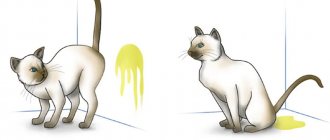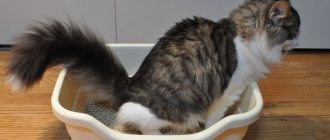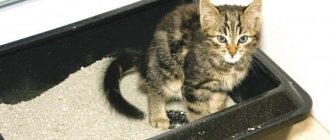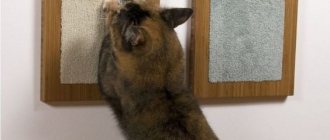The process of litter box training can be quite slow, and you need to be mentally prepared for this. Once in a new home, the pet will experience stress from the change of environment. Before he engages in the training process, he must calm down.
For an adult cat that has already been trained to use the litter box, a change of residence is unlikely to interfere with the ability to navigate the new environment and begin using the toilet correctly. The situation will be much more complicated if a pet from a shelter or from the street appears in the house. Owners need to prepare themselves in advance for the hard work ahead.
How to arrange a cat litter box
If the animal finds it uncomfortable to go to the potty, he will soon choose another, more comfortable place. Therefore, it is important to choose the tray and litter according to your cat's preferences, and then install it in an appropriate location.
Selecting a location
Cats by nature love to hide. Some individuals are embarrassed to go to the toilet in an open space and in front of people. To make your pet as comfortable as possible, you need to place the tray in a quiet place with open access.
Many owners prefer to install the cat litter box in the restroom and leave the door ajar. Another option is a special slot in the door for easy access for the mustachioed. For many families, this is the only acceptable option: unpleasant odors will not spread throughout the house, and the cat will be able to go to the bathroom alone.
If it is not possible to place a tray in the bathroom, you can consider the option of a closed tray-house: it can be placed anywhere in the apartment. The cat will be hidden from prying eyes, and unpleasant aromas will not leak through the thick walls. The only negative is that a kitten is unlikely to like such a house; this is an option for an adult pet.
It is advisable to limit the pet’s movement area to any one room in which the tray is located while the skill is being developed. Then he will quickly learn the place of origin of his needs.
Buying a litter box and cleaning it
It is better to choose a tray from non-electrifying plastic with fairly high sides, about ten centimeters (for a kitten - lower, up to five centimeters). It should be roomy enough so that the pet can comfortably fit in it and be able to cross its paws. If the cat is not from the street, but simply changed its owner, ask the previous owner what kind of litter box the pet used - this will help accustom it faster.
Cats like closed structures in the form of houses more, as they create a feeling of seclusion, but caring for such toilets is much more difficult than a regular litter box. An additional advantage of closed toilets is the presence of special filters that absorb unpleasant odors.
Perhaps the most popular option for cat litter is a plastic tray with a removable grid. But it is not suitable for all pets. Some cats outright refuse to use a tray with stale litter: they are afraid of getting their paws wet.
Therefore, the tray must be cleaned regularly: it is necessary to change the filler and wash the tray with a disinfectant. Be careful not to use chemicals that are too odorous - they may scare the animal away and force you to avoid the potty.
Some cats absolutely need sterile cleanliness: they meow loudly and follow the owner so that he cleans up their feces immediately and immediately. Others are less scrupulous and may use the used tray several times.
Purchasing filler
It is much easier for an outdoor cat to get used to a tray with a filler that resembles sand or sawdust (mineral, wood). At first, you can use sand from the street, into which portions of filler are gradually mixed.
If your pet is accustomed to a particular litter, you should not suddenly change it to another, since you will have to accustom an adult cat to the litter box all over again - he will simply boycott the unfamiliar potty. You need to gradually mix portions of the new mixture into the old one until you completely replace it and the animal gets used to it.
For kittens it is better to use natural (wood, soy, coal) fillers. This is due to the fact that the baby may try the granules on the tooth out of curiosity. Later it will be possible to transfer it to a mineral or silica gel filler.
Filler
Today there are a large number of different fillers:
- pressed sawdust;
- silica gel;
- cellulose;
- scented sand;
- clay.
Each type has its own advantages and disadvantages. Absorbent fillers should be changed frequently and the container should be washed to eliminate odors. The filler should not generate dust or have a strong smell. The owner may like the smell of lavender, but it will irritate the baby’s delicate sense of smell.
It is worth considering that a person has 5 million receptors responsible for the perception of smell, while a cat has 200 million. Veterinarians advise giving preference to natural substances when choosing litter for a kitten’s litter box, and although silica gel absorbs moisture and odors well, a curious baby may want to taste it.
The delicate pads of a kitten's paws can be sensitive to large crystals and pellets, so for the baby the filler should be not only safe, but also comfortable - soft and without sharp corners. The mineral filler absorbs moisture well and is quite comfortable for the paws, but may contain allergens - bleach and asbestos. In addition, it becomes very dusty when falling asleep.
Clumping litters are also not suitable. When clay comes into contact with urine, it forms lumps that can be easily removed with a mesh spatula. This filler is convenient. Economical, but it sticks to the kitten's paws. It is worth taking into account the pet’s preferences in the level of backfill. Some people prefer to rummage for fun and need a thick layer of filler. Others have enough minimum to get everything done comfortably.
Fillers made from processed grain have long been preferred abroad. They are safe, environmentally friendly, and do not emit strong odors.
In our country, this type is represented only by Natural Miracal products made from processed corn cobs. It is not cheap, but it is a clumping type, reliably holds odors and can be thrown into the toilet.
How to train a kitten to use a litter box
A small pet is just beginning to explore the world and learn new things, so it will not be at all difficult to develop the skill of going to the toilet; training an adult cat to use the litter box is usually more problematic. Under no circumstances should you show aggression or anger if things don’t work out as quickly as you would like.
The optimal age for an animal to begin training is 2-6 weeks. The main guarantees of success: the correct choice of tray, its installation location and filler. A kitten should not buy a tray with very high sides “for growth”, otherwise he will refuse to use it due to inconvenience. For the same reason, it is better not to install a toilet-house as the first tray.
A kitten goes to the toilet more often than an adult animal. If you notice that the baby is restless, scratching his paw on the floor, walls or furniture, or spinning in one place, immediately carry him and put him in the tray. Do not create a fuss while doing this; the pet may get scared. You can help the cat and, taking his paws in your hands, scratch the litter.
Wait until the baby does his business, and then praise him. You should not give him a treat: encouragement with your voice and stroking will suffice.
Sometimes it is enough to carry out such manipulations several times, and the animal understands what they want from it. It happens that it takes much more time, please be patient.
If the kitten misses, there is no need to scold him or scream: he will be scared and is unlikely to understand what happened. Point him to the puddle, and then take the baby to the tray.
Some owners are lucky and do not face the problem of toilet training their animal. If the kitten they adopted grew up with a cat mom, chances are she taught him everything.
Teaching an adult cat to use the litter box
Cats are smart animals. This means that even the grumpiest adult cat can be trained to defecate in the litter box. You need to make the experience attractive to her.
- Do not use a closed litter box . Covering the litter box with a hinged lid will hide the sight and smell of cat waste. However, cats feel vulnerable when they are doing their thing. If they are inside a strong box with no easy way out, they may become stressed.
- Do not use scented litter . If you have a cat that is not spayed, his urine will smell strong. Resist the temptation to mask it with a flavorful filler. Cats are led by the nose. If they find the smell of the litter box scary, they will stay away.
- Have multiple trays . You might think it would be helpful if your cat only has one litter box. However, they will learn faster if they have multiple toilets.
- Make the trays uniform in size and shape . They should have low edges so that an adult cat can get in and out easily. However, you can experiment with different brands of litter.
Once you've completed these basic steps, you'll be ready to begin toilet training. Once you have the proper equipment, all you need is patience. This is a different problem than when your cat suddenly stops using the litter box.
How to train an adult animal: algorithm of actions
Adult felines are very scrupulous and picky about the toilet. They are disturbed by noise and various external stimuli. To fulfill their natural needs, they instinctively choose hard-to-reach, secluded corners, for example, places behind a closet or behind a sofa, where it is quiet and there are no prying eyes. Therefore, while the animal adapts, it is better to play it safe and block off such areas.
There is no difference in learning ability between male and female cats, especially for sterilized pets.
When working with an animal, you should take into account that each pet has its own character and level of intelligence. Some people learn to use the litter box fairly quickly, while others need time to form the desired habit. Difficulties usually arise when training adult pets - especially if the cat came into the house from the street, where there were no rules for the discharge of natural needs.
To develop the necessary skill in your pet, you need to place the cat litter box correctly. It should always be available and located in a convenient location. A bathroom or a warm loggia are the most suitable options.
The animal must be explained what a tray is and for what purposes it is used. This must be done patiently and calmly, without getting irritated, much less without any physical influence. Cats are very smart creatures; they respond well to changes in voice intonation. Take advantage of this. Barbaric methods like poking your nose into a puddle will not speed up the learning process, but, on the contrary, will complicate the task, increase the duration of adaptation and turn your pet into a frightened creature.
A scheme for training an adult cat to use a tray to obtain the fastest results may look like this:
- The need to relieve oneself in animals usually occurs after eating. For the first time after a cat appears in the house, do not leave it unattended. When the animal has eaten, carefully take it to the tray. Sit near the cat, wait. When she relieves herself, praise and pet her. But don’t rush to clean the litter box – let your pet form an olfactory connection.
- The animal may want to go to the toilet not immediately after a meal, but at another time. Signs of this are as follows: the animal begins to worry, sniffs corners, and scratches the floor. In this case, you need to take the pet to the litter box, wait until everything is over, and praise it.
- If it happens that you didn’t notice and the cat did its “dark” business in the room, then do not rush to punish it. Blot the puddle with a napkin and take it to the tray. Let your pet smell it. If the cat came into the house from the street, sprinkle the puddle it made with sand and take the wet sand to the tray. Give your pet a chance to explore the litter box and form an olfactory connection. The place where the puddle was must be washed with perfume or strong-smelling substances: vinegar, alcohol, kerosene. You can drop and rub a couple of drops of essential oil with the aroma of citrus or lavender on the washed area.
- It happens that the pet himself chose a place for the toilet, and it does not coincide with where the tray is located. In this situation, there is only one way out - put the tray in the place that the cat chose. Once the habit is established, begin to gradually move the tray so that over time it ends up in the place you want. The movements need to be made small: 1-2 centimeters per day.
- Don't take risks and don't leave outdoor shoes in the access area. The smells of the street can provoke the animal, and it will be very difficult for you to rid your favorite shoes of cat odors.
- If another cat previously lived in the house, treat the area where her litter box was located with a strong-smelling compound. Cats' sense of smell is unique. A new resident may be able to smell the scent even if several years have passed and will be tempted to mark the area.
- In pet stores you can purchase a special spray for toilet training a cat, which is recommended for treating the litter box. There are also sprays with a repellent odor, which are recommended for treating risk areas, such as the hallway.
If the cat knows where the tray is, but periodically goes to another place, you need to take a good look and look for the reason. Perhaps something is bothering your pet.
Where is the best place to put it?
So, how to quickly train a kitten to use the litter box. Of course, it is unlikely that you will be able to do this during the day. But here there are certain rules. First you need to place the tray correctly .
It should not be installed where strangers frequently walk. Many people place a cat toilet in the bathroom, but this is wrong, as the animal may be frightened by the sharp sounds of the washing machine or clothes dryer. The cat should feel safe and private. If you place the tray in a visible place, the kitten may refuse it and begin to relieve itself in a hard-to-reach place, for example, behind the sofa. It is best to place the cat litter box in an area where the kitten frequents. He must see it constantly and be able to use it at any time. If for some reason the cat litter box has to be rearranged, then this should be done gradually. It is better to move the tray in the desired direction by just a few meters during the day. If you suddenly rearrange the tray, the kitten may simply become confused. After this, the animal will relieve itself wherever it pleases.
Is it possible to teach a cat to go to the toilet?
Some cat owners do not want to install a litter box in their apartment; they prefer that the animal go to the toilet on the toilet. But you won’t be able to completely avoid using a cat potty, since you can accustom a cat to a litter box, including an outdoor one, only through an “intermediate object,” namely a litter box. An animal that is not familiar with the litter box will not be able to learn to relieve itself on the toilet.
If your pet clearly knows that her business needs to be done in the tray in a strictly designated place, you can move on to changing habits - going to the toilet to the toilet. Do everything gradually. If you rush, you'll have to start all over again. Move the tray every day by 1-2 cm, moving it towards the location of the toilet.
For the next stage of training, prepare a large stack of paper, newspapers or magazines. Place newspaper under the tray after each use. Do not put too much at once - no more than 1 cm at a time. Otherwise, the pet may begin to show character and go on strike, leaving puddles on the floor.
In the process of raising the structure, the amount of filler should decrease. The best option is ꟷ if you didn’t use it from the very beginning. Be careful about the stability of the stack of newspapers. If the structure collapses at the most crucial moment, the animal may become frightened, and all training will go down the drain.
When the tray is at the level of the toilet, secure the result and let your pet finally get used to it. After a few days, you can move the tray onto the toilet itself and remove the pile of paper. Make sure everything is installed securely. It is better if you raise the seat; without plastic elements, the design is more stable, and this is very important.
At the last stage, you need to remove the tray; it is better to take it out of the apartment altogether so that the animal cannot find it by smell. When the cat wants to go to the toilet, she will be forced to use the toilet. After all, the tray had been standing there for the last few days.
There are times when your pet refuses your proposed plan at this stage. There may be signs of protest on the floor. In this case, you should return the tray to the toilet and try again.
There is another option for completing training - longer, but more reliable. To implement it, cut the bottom in the tray, gradually increasing the diameter. When the hole is the same as in the toilet, you can simply throw away the sides from the tray. And the cat is guaranteed to do his business in the desired place.
Some owners resort to a special tray attachment for the toilet - it also does the job well. But the attachment is used at the last stages of training, so a regular tray will still be needed at first.
There are two important rules for toilet training an adult cat: the toilet lid should always be up and the door to the toilet should always be open.
Habit Formation
Animal psychologists say that there will be no problems with training a kitten to a certain toilet, if you take into account its instincts and desires. An important condition for the formation of a stable habit is:
- convenience;
- comfort;
- attractiveness;
- compliance with instincts.
This means that the “latrine” should be located in a calm area - a secluded and quiet place. Most cats do not like to be disturbed by noise, movement, or unnecessary attention from others while relieving themselves. Therefore, the litter tray is placed in a secluded place with easy access. The tray should be:
- convenient;
- take into account the age and size of the cat;
- easy and quick to clean;
- do not absorb odors.
Sometimes a kitten may need 2 trays. Some animals prefer to urinate in one container and defecate in another.
You must immediately select the appropriate filler. Cats bury their excrement. This behavior is driven by instinct. The smell of feces carries information about its owner. From it, other animals can determine where the hole is, who lives there, what its gender and age are, and how many inhabitants there are.
Such information is dangerous if the enemy finds it out. Therefore, for convenience and speed of training, there should be a filler in the tray so that the kitten can bury its feces. It has special requirements. If a cat leaves feces in the wrong place and uncovered, then he declares his status as the owner of the house. You should not poke your baby's face into traces of a crime. You should reconsider your relationship with the animal and persistently but gently show who is boss.
Smells play an important role in a cat's life. A kitten, whose eyes have not yet opened, orients itself in the world around it solely with the help of smell. And later the nose perceives important information. Therefore, the tray should always be clean, smell attractive (from the kitten’s point of view) and not emit any sharp, frightening aromas.
In addition to keeping the tray private, it should be located away from food and water bowls. This is also fixed at the level of instincts. After all, in the wild, cats go to the toilet on the border of their territory - away from the hole and the place of eating. Moreover, each time they defecate in a new place, carefully burying “traces of activity.”
In an apartment, the owner cannot provide the kitten with such conditions, but it is worth creating as comfortable as possible and satisfying most of the instincts. From this point of view, the research of Jackson Galaxy, a zoopsychologist, felinologist and cat expert with extensive practical experience, is interesting.
Training aids
Since all owners want to accustom their cat to the litter box quickly and forever, they often begin searching for aids. Special sprays can be good helpers. There are two types of pharmaceuticals:
- with an attractive effect;
- with a repellent effect.
The principle of operation of the first type of products is based on the fact that their smell attracts the cat, forcing it to go to the toilet in the right place. The secret of this effect is simple: it contains urea, in other words, urea. Therefore, some cat owners do not want to purchase an aerosol; they simply moisten a napkin with the animal’s urine and place it in the right place. But using a spray is much more convenient, and such preparations are inexpensive. The product should be sprayed around the tray: on a piece of paper left nearby, or on the filler itself.
Sprays with a repellent effect are used to treat potentially at-risk areas, such as shoes, places behind furniture, and rugs. It is also recommended to use them in areas where the animal has already left a puddle.
All specialized products are absolutely safe for cats. But there are people who prefer folk remedies, for example, lavender oil. Use a few drops in the place where the animal gets into the habit of going to the toilet - the aroma repels cats well.
Citrus fruits also seem unpleasant to cats - you can leave the peels of oranges or tangerines in the place where the animal has shitted several times.
Lifehacks for first-time cat owners
- Try not to leave your baby for a long time. If you are leaving for several hours, at first it is better to close unnecessary doors and leave him in an isolated area, not far from the litter box. This will minimize any unpleasant surprises.
- Do not place the tray next to bowls. Cats don't go to the toilet where they eat.
- If your cat ignores the litter box, change the type of litter. Perhaps you got a picky person who doesn't like certain textures or smells. Try getting a spare litter box: Some cats prefer to use different litter boxes for different things. There are clean cats for whom it is important that the toilet is always clean and fresh.
- If the kitten has chosen the wrong place, you can try to cover it with something smooth, rustling and sticking to its paws, for example cellophane, cling film, foil. Cats do not like to go to the toilet on such surfaces.
- Do not experiment with nutrition and provoke eating disorders. Follow the diet recommended by the breeder. In the case of a foundling, do not rush to feed it everything at once. For example, contrary to popular belief, dairy products are difficult to digest and often lead to bowel problems.
- Reinforce positive results with praise and your favorite treat.
Did your cat quickly learn to use the litter box?
Reasons for possible difficulties
When developing the skill of defecating in the right place, difficulties sometimes arise. They can be caused by various reasons. Just watch your pet to understand why training is so difficult.
Sometimes it happens that an animal went to the toilet in the right place, and then suddenly stopped. In this case, you need to understand what causes this behavior and how to re-accustom an adult cat to the litter box.
Disease
The most dangerous and unpleasant reason for refusing to go to the toilet is illness. If something is bothering your pet, he may change his behavior in an attempt to let you know that something is hurting him.
In some cases, due to illness, he simply forgets where to go to the toilet, or this process causes him severe discomfort and pain. This may be urolithiasis, kidney failure or cystitis. If you notice changes in the animal's behavior, anxiety, lethargy, or other symptoms of the disease, you should contact your veterinarian. After the course of treatment, your pet will recover and, most likely, will return to its usual toilet.
Stress
Litter box refusal can also be caused by stress. It is worth considering that cats, like people, have different personalities and stress tolerance. Therefore, each requires a special approach. Limit the animal from stress as much as possible, be patient, do not punish the cat for mistakes - and very soon she will understand what you want from her.
It happens that changes in life circumstances cause anxiety in an animal. For example, a new person has appeared in the family or someone has died. In this case, try to devote as much time as possible to your pet. If you have a second cat, you should designate a litter tray for each pet.
New tray or new place
Cats are animals that do not tend to change their habits; they quickly become attached to their territory and certain places. Therefore, when changing the tray, a problem may arise such as refusal to go to the toilet in the usual place. What can we say about moving?
If you change the tray, sometimes you have to start training again - be prepared for this. If you are planning a move, make sure the new location has privacy areas for the cat and elevated areas for observation. The fewer reasons for stress the animal has, the better the adaptation will be and the fewer problems will arise with the toilet.
The period of sexual hunting
Sometimes difficulties are caused by the so-called mating season. It’s quite easy to check whether a cat leaves marks intentionally or whether there is another reason for his behavior. If the pet becomes more restless - it looks from the outside as if he is looking for something - and the animal urinates in small portions on a vertical surface, then we can definitely talk about the cat’s sexual activity. The solution is castration or regular mating with a cat.
Psychological reasons
There is an opinion that a cat can leave puddles out of spite, thus showing its stubbornness and discontent. Not all experts recognize this possibility - there are supporters of the theory that cats do not have consciousness, therefore, they do not know how to take revenge. In fact, many owners know that a cat can take a shit if it is offended - but almost immediately. Animals are definitely not capable of delaying revenge and serving it cold.
If your pet is loved and caressed, but he still walks in the wrong place, first of all you need to rule out the disease. If everything is fine in this regard, you need to decide how to most gently accustom an adult cat to the litter box again, taking into account the identified reason: often puddles or piles become an attraction for the owner’s attention. A couple of examples:
The cat feels sad when left alone for a long time. The owner returning late finds a fragrant “gift” in an unexpected place. Getting a second pet will solve the problem.
The cat likes or doesn’t like something. If he wants to go for a walk, but they don’t let him in, he can shit under the door. Or there is a desired item in the closet, which means the cat can go near the door of this closet.
More complex causes are difficult to identify. Sometimes monitoring an animal takes several weeks, or even months. But patient owners cope with the problem, no matter how ingenious it may be.
If the cat chooses the wrong place
In some cases, cats choose one specific place as a toilet. And all the owner’s efforts to train them can be completely ignored. In such a situation, you will have to put in a little more effort.
A tray should be placed in the place where the pet constantly relieves itself. Soon the cat will begin to go into the litter on its own. Then you need to start gradually moving the entire tray in the direction where it should be. There is no need to rush with this; it is best to move it a not very large distance.
The pet will be able to get used to the tray and will hardly notice the movement. However, the place where he relieved himself before this should be fenced off. If it remains open, then there is a high probability that the cat will go there again.
What not to do
Under no circumstances should you punish your pet. If you start poking your animal’s nose into his feces, he will not understand that he is being scolded for going to the toilet in the wrong place; he will simply regard this as a punishment for a completed physiological act. In the future, the cat will hide from you in more secluded places in order to carry out its “dirty deeds”.
You should not forcefully hold your pet in the tray while waiting for him to go to the toilet. The animal will simply get scared and will avoid the tray.
The cat will definitely understand what they want from him - you just need to be affectionate towards your pet. It is not an easy task to accustom an outdoor cat to a litter box, and the result will depend on how you behave. The main key to success is patience; after a certain amount of time, the cat will definitely figure out what to do, and you will find happiness and peace.
Do you like the article? 198
First meeting
Since teaching a kitten to go to the litter box is a complex process, you must follow all the rules . This is the only way to get results. In addition, it is important to introduce the animal to its toilet on the very first day it appears in your home. To do this, the kitten should be placed in a tray previously filled with cat litter. This will allow him to get used to the smell and new sensations under his paws.
The kitten must sit in the tray for a certain time. He must study it. Even if the animal does not want to go to the toilet, it is necessary to periodically put it in the tray. This can be done immediately after he wakes up, after each meal. If the kitten decides to go somewhere else to relieve itself and starts to sit down, you should immediately transfer it to the tray.
Features of training an adult pet
If an adult cat has only recently appeared in your apartment, be prepared for the fact that even during the period of adaptation to the new environment, it may show waywardness and even capriciousness. In addition, by nature, a cat is a domestic creature that takes the need to correct its needs very seriously. Such pets simply adore hard-to-reach corners, because this allows the process itself to provide some intimacy, and this is what cats always strive for. That is why if a pet that has just arrived in your family does not like a toilet with bars or high sides, or is overly frightened, the result will be the same: the cat will certainly find a new corner for this area, but his intentions will not be compatible with your preferences.
The first thing you should take care of in order to avoid the appearance of puddles on the floor is to limit your pet’s access to various nooks and crannies (areas under cabinets, armchairs, behind sofas). Don't forget that your cat's preferences should also be taken into account. Over the years of its life, each furry individual has formed certain habits regarding toilets. So don’t be surprised if a cat who has lived outside for several years defines any pots and flowerpots with indoor plants as a litter box.
When choosing a location for the cat litter box, consider the fact that it should be easily accessible for your pet. However, you should not place the tray in the kitchen or in the hallway.
Another key point to keep in mind while you're trying to toilet train a new pet is to keep your pet in the room where the litter box is located for a period of time. He must get used to it, then he will recognize his toilet much faster.
How to stop an adult cat from shitting
To protect your home and furniture from being “mined” by your cat, experts recommend starting with studying the animal’s health. He may need to be treated. If the cause of the marks is hormonal activity, it is recommended to sterilize the pet.
Uncontrollable urination can be caused by diseases, including infectious diseases caused by flea bites and other parasites. Therefore, take care of hygiene and regularly wash your pet with special shampoos, wear an anti-parasitic collar and be sure to treat it with a spray or other insecticidal preparations during the insect active season.
It is also recommended to take the following measures:
- make it difficult or completely block access to an unwanted toilet area;
- provide free access to the tray;
- wash the unwanted area with detergents and treat it with a special spray or citrus essential oil, and treat the tray with a spray that attracts the animal’s attention;
- praise, stroke and pamper with delicious food every time the cat visits the tray;
- try several litters and buy only the one that your cat likes: so that it absorbs moisture and odors and does not cause discomfort.
Is it worth punishing if the cat does not go to the litter box?
If the question of how to accustom an adult cat to a litter box in a new home is not resolved immediately, shouting or resorting to physical punishment is not only unnecessary, but also harmful. Cats are excellent at distinguishing intonation, and your dissatisfied voice will be a signal that “something is wrong.” The animal will be offended by shouting or beating and will deliberately spoil your things.
Moreover, in order to hide the Skoda, the cat will begin to look for more and more inaccessible and hidden places. As a result, the smell will spread throughout the house, and it will become more and more difficult for you to find its source each time. The cat will have negative associations with the litter box, and it will be even more difficult to train your pet to use it.
Don’t be lazy each time to explain to your pet what is required, take the excrement to the tray and bury it. You can even try burying the waste with your pet’s paw, and then praise it and treat it to something tasty. Usually, after 3-5 repetitions of this procedure, cats themselves begin to run around the house at the right moment in search of the “right” place for the toilet.
If the cat periodically “does not get” to the intended place, it is worth showing it to a veterinarian. Perhaps the animal has pain in the kidneys or genitourinary organs.
Health problems
If a cat, accustomed to its litter box, suddenly begins to go to places undesirable for the owner, the cause may be diseases of the urinary or reproductive system. In this case, you don’t just need to stop your cat from pooping on the bed or other unwanted places, it’s important to pay attention to its health. Cystitis, inflammation of the uterus or ovaries, bladder stones and other diseases can cause the animal to become unclean. To fix a toilet problem, you need to treat the underlying condition. Exacerbation of inflammatory processes most often occurs during the cold season.
If puddles and heaps appear at the exit of the house or onto the balcony, they indicate the imminent onset of heat in a cat or the sexual desires of a young cat. This behavior can easily be eliminated by spaying, neutering or taking sedatives.
Another reason is more of a social nature. If the animal has a conflict with its owner or another pet has appeared in the house, problems with going to the toilet may also arise. Competition forces cats to divide their territory using marks, violating the toilet rules established by humans.
Types of cat litter boxes
- Traditional - a toilet with low sides, rectangular in shape. Most models have grilles. It allows you to keep your cat's paws clean. This pot does not take up much space and is easy to clean.
- Tray with sides – there is an additional high side, which is secured to the edges with clamps. Suitable for those cats that often miss and dirty the walls or like to play with the litter after going to the toilet.
- A closed tray - a house - allows the cat to feel protected. It retains unpleasant odors and therefore can be placed anywhere in the apartment. The only drawback is the large size of the toilet.
- Dry toilet - similar to the previous version, with the difference that special carbon filters are built into the design of the tray, which perfectly absorb any odors, and a shovel. Replacement odor filters last for 5-7 months.











